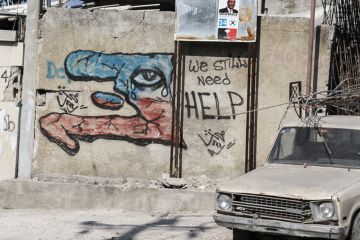
I am writing from a government-mandated, fourteen-day self-quarantine, now a standard procedure for those who have travelled outside of the country in the past two weeks. Like many, I was surprised at the rapid progression of events surrounding COVID-19. When I left Canada, there were 21 cases of coronavirus in the United Kingdom—none in Scotland, the country that I was visiting. Upon my return home, just ten days after my arrival abroad, the number of cases had risen astronomically. Hundreds of Britons were infected with the virus and community transmission had been detected. It was becoming increasingly clear that the coronavirus would not be limited to China. In the startlingly fast escalation of the crisis, the World Health Organization declared COVID-19 a global pandemic.
While the primary focus has been on containing the spread of the coronavirus and treating those who are suffering from it—as it should be— the outbreak has led to increasing instances of human rights violations. As the virus spreads with startling swiftness, it is pertinent to look at the ways in which governments across the world are treating their populations. In the urgency of containing its transmission, some governments have taken advantage of the situation to implement human rights abuses that satisfy agendas independent of protecting public health.
In the United States, the Trump administration has announced a plan to return all asylum seekers who enter the country in an unauthorized manner to Mexico without being given the right to seek asylum.1 Known for its anti-immigrant agenda, the Trump administration is once again violating both US and international human rights law, this time using the COVID-19 pandemic to weaponize Americans’ fear of the virus.2 In Iraq, all public gatherings were banned amidst a stream of anti-government protests, despite only one confirmed case of coronavirus in the country at the time of the ban.3 In Bishkek, Kyrgyzstan, against the backdrop of demonstrations for the release of a politician before parliamentary elections, all protests were banned in the city center until July 1st.4
During times of public emergency, human rights law allows for restrictions on rights, provided they “have a legal basis, are strictly necessary, based on scientific evidence and neither nor discriminatory in application, of limited duration, respectful of human dignity, subject to review, and proportionate to achieve the objective.”5 While the scale of the pandemic is certainly sufficient to qualify as a public emergency, it is imperative that limits are in place to prevent an erosion of human rights after the crisis has ended.
China has implemented software on citizens’ smartphones that evaluates their risk for COVID-19 and indicates whether they should quarantine or be allowed into public spaces. No information has been provided to clarify how it classifies people, leading to some individuals being instructed to self-isolate without being told why. It has also been found to send information to the police, including location, city name, and an identifying number, creating the possibility for increased state surveillance even after the end of the coronavirus outbreak.6
Israel has allowed security services to hack the phones of those infected with the virus in order to track their activity.7
In the UK, officials now have the power to arrest and detain those they believe are infected with COVID-19 for as long as 14 days, to move that person between custody facilities and secure hospitals, and to take blood and saliva from them without their consent. Further legislation is before parliament now that could widen police and immigration powers of detention and restraint, allow doctors to sign death certificates without seeing the body of the deceased, and allow the exercise of “reasonable force” on those who refuse to self-isolate.8
The COVID-19 pandemic has created conflicts between ensuring that public health measures to protect the population are in place and the rights to liberty and privacy. As COVID-19 continues to sweep the globe, many citizens face uncertainty as their governments respond to the public health crisis.
Edited by Alisia Bello
1. “US: Plan to Shut Border Endangers Asylum Seekers.” Human Rights Watch. March 18, 2020. https://www.hrw.org/news/2020/03/18/us-plan-shut-border-endangers-asylum-seekers.
2. Sampogna, Anne. “Presumed Innocent: Cash Bail and Pretrial Detention in the United States.” Journalists for Human Rights at McGill Student Chapter. February 25, 2020. https://jhrmcgill.ssmu.ca/2020/02/25/presumed-innocent-cash-bail-and-pretrial-detention-in-the-united-states/
3. Rutzen, Doug and Nikhil Dutta. “Pandemics and Human Rights.” Just Security. March 12, 2020. https://www.justsecurity.org/69141/pandemics-and-human-rights/.
4.. Rutzen, Doug and Nikhil Dutta. “Pandemics and Human Rights.” Just Security. March 12, 2020. https://www.justsecurity.org/69141/pandemics-and-human-rights/.
5. “Human Rights Dimensions of COVID-19 Response.” Human Rights Watch. March 19, 2020. https://www.hrw.org/news/2020/03/19/human-rights-dimensions-covid-19-response.
6.. Mozur, Paul, Raymond Zhong, and Aaron Krolik. “In Coronavirus Fight, China Gives Citizens a Color Code, With Red Flags.” New York Times. March 1, 2020. https://www.nytimes.com/2020/03/01/business/china-coronavirus-surveillance.html
7.. Hirsch, Afua. “The coronavirus pandemic threatens a crisis for human rights too.” The Guardian. March 19, 2020. https://www.theguardian.com/commentisfree/2020/mar/19/coronavirus-pandemic-human-rights.
8. Hirsch, Afua. “The coronavirus pandemic threatens a crisis for human rights too.” The Guardian. March 19, 2020. https://www.theguardian.com/commentisfree/2020/mar/19/coronavirus-pandemic-human-rights.




